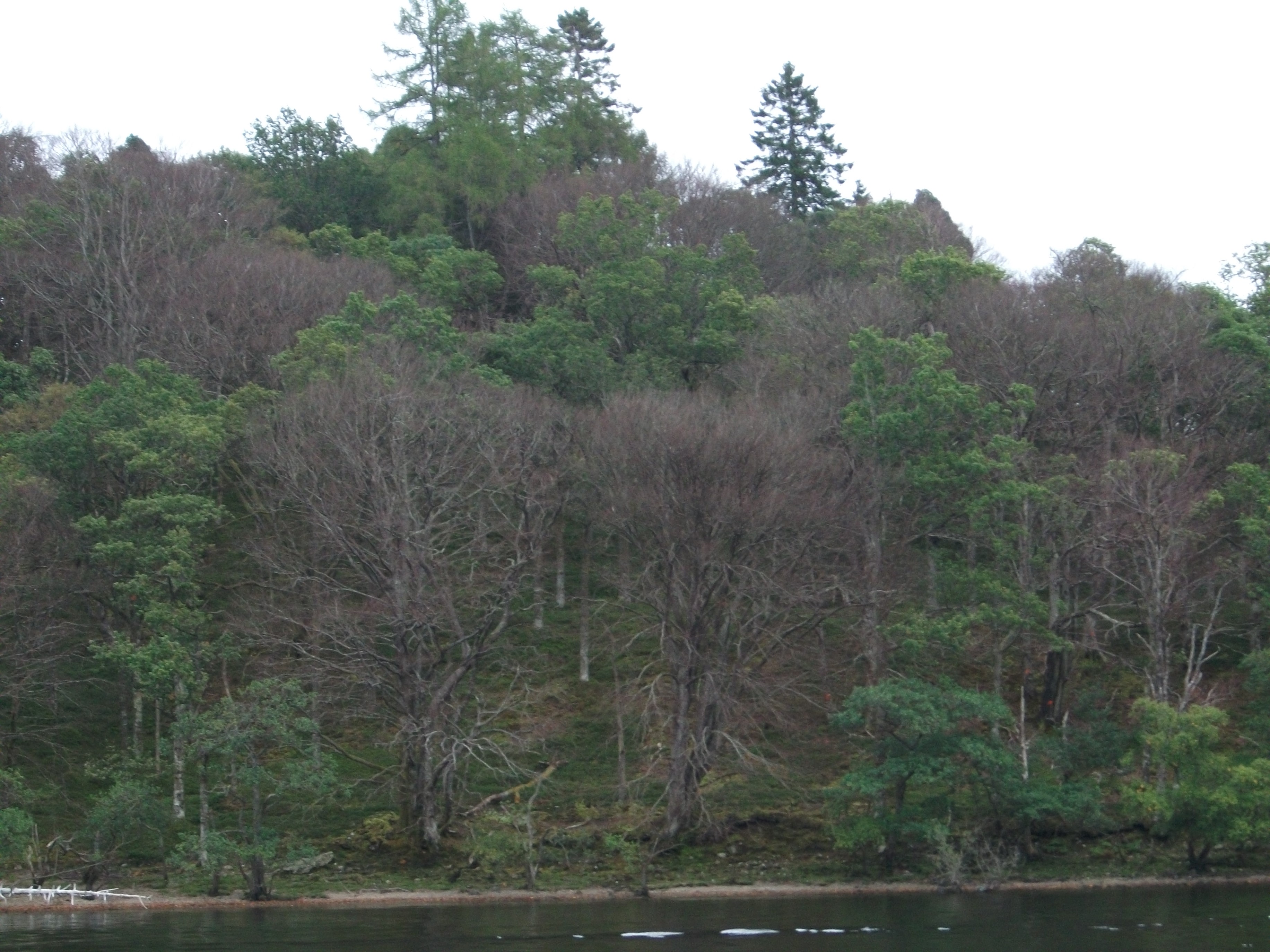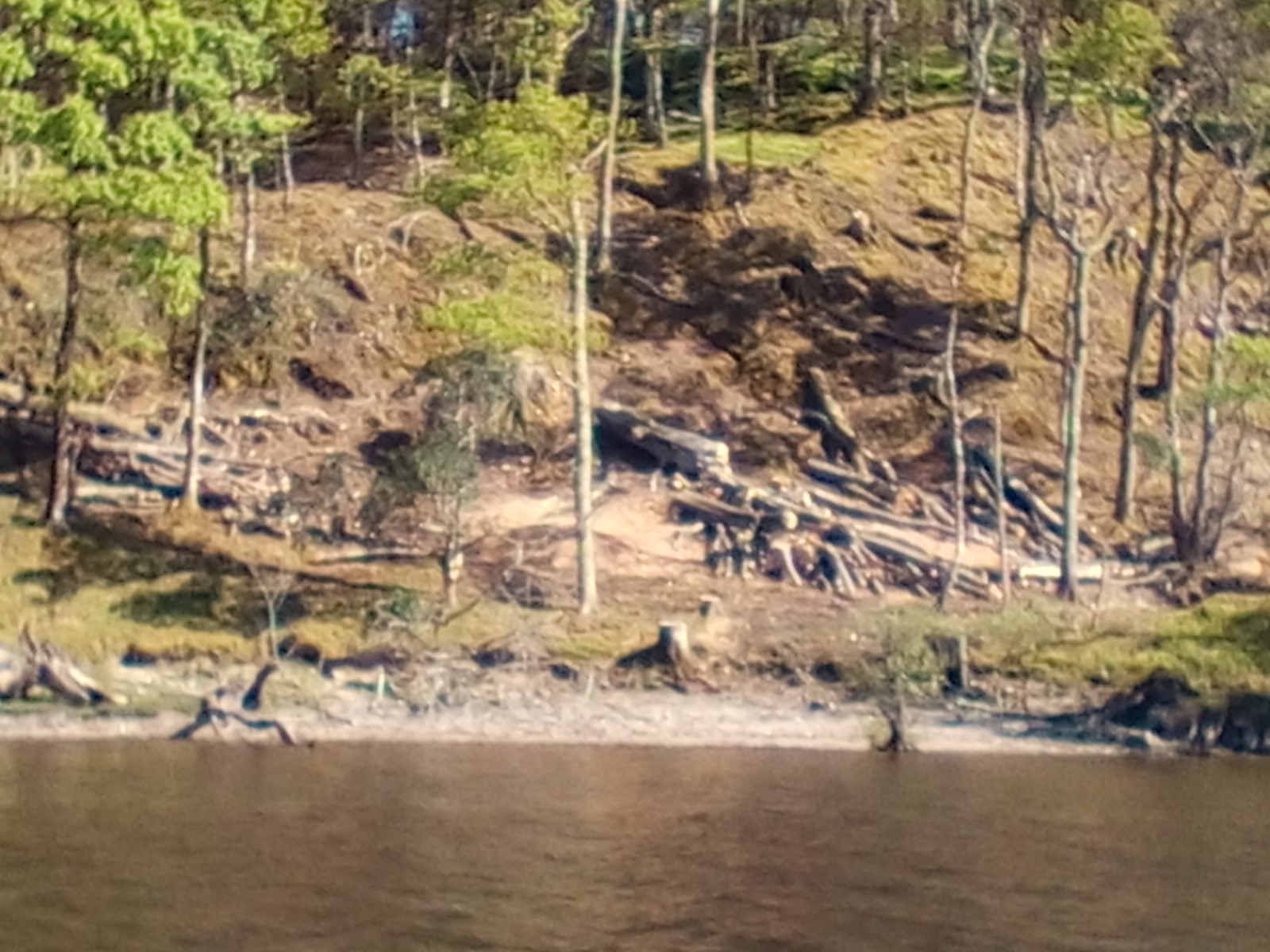By Mary Jack

History
Perhaps one of the best travel books ever written about Scotland is The Companion Guide to the West Highlands of Scotland [1968] by W.H.Murray. Early on he touches on Loch Lomond:
The banks of Loch Lomond are clothed by deciduous woods. Oak, beech, chestnut, larch, and birch predominate … That the banks of Loch Lomond have remained so long free from the forester’s axe and from impairment by tourist development appears well-nigh miraculous. Their preservation has been due to the rule of enlightened landowners, principally the Colquhouns of Luss, who have sacrificed personal profit.
All this changed in 2015 when a heritage organisation was accused of carrying out ‘wanton vandalism’ on the island of Inchtavannach on Loch Lomond. Scottish Natural heritage is said to have poisoned hundreds of beech trees, some of which were 300 years old.
Luss Estates, who own the island, said SNH had entered into an agreement with the tenant of Inchtavannach in 2013 to remove rhododendron from the island. That agreement also provided for the mature beech trees to be felled gradually over a five year period. But it is said SNH had decided to ring-bark and poison the beeches instead.
At the time Sir Malcolm Colquhoun was quoted as saying “I simply cannot understand why the supposed guardian of our natural heritage has killed off these wonderful trees for no apparent reason.” SNH were reported as stating they “didn’t appreciate” the effect this would have on the landscape. You can read more at:
lussestates.co.uk/news/beech-trees-poisoned-inchtavannach-island
So why were the 300 year old beech trees killed?
The agreement between SNH and the tenant apparently included measures to remove “non-native” beech and this was included in the Management Statement InchtavannachSSIsite808-doc3 for the island which is a Site of Special Scientific Interest. While SNH claimed the beech trees were non-native, elsewhere it had written:
“The importance of a wood for biodiversity is closely related to its age. In Scotland, Ancient Woodland is defined as land that is currently wooded and has been continually wooded, at least since 1750” (History and ancient woodlands – Scottish Natural Heritage)
Moreover, according to the Woodland Trust (what does native and non-native mean?):
The term native is used for any species that has made its way to the UK naturally, not intentionally or accidentally introduced by humans. In terms of trees and plants, these are species that recolonised the land when the glaciers melted after the last ice age and before the UK was disconnected from mainland Europe.
While according to Forestry Commission Scotland (What are Scotlands native woodlands?) http://scotland.forestry.gov.uk/
Ancient woodlands usually have a high value for natural and cultural heritage because of their long history of continuous woodland cover. Ancient and semi-natural woods (i.e. those where the current stands appear to be naturally regenerated rather than planted) are the woodland category that generally has the highest biodiversity value.
Native tree species are those which arrived naturally in Scotland without direct human assistance as far as we can tell. Most of our native tree and shrub species colonised Scotland after the last Ice Age (which ended roughly 9,000 years ago), with seeds dispersed by wind, water, and animals.
Although not native to Scotland, the beech – or Fagus sylvatica in Latin – is a common tree across much of Europe. It’s thought beech trees arrived on our shores during the Bronze Age.
Conflicting or what?? So ancient woodland sites are important to conserve but need to be cleansed of beech trees which have been there for 300 years?
And now we have been told ………………..beech trees are native to Scotland after all, scientists discover
According to research announced on 4 July 2017:
Beech trees should be considered native to Scotland – despite a long-running debate over their national identity, researchers at the University of Stirling and Science and Advice for Scottish Agriculture (SASA) report. The team examined the DNA of more than 800 beech trees at 42 locations across Great Britain and made direct comparisons with trees growing on mainland Europe.
The study – funded by the Natural Environment Research Council (NERC) – shows almost all of the beeches growing in Great Britain the researchers tested, are derived from native populations and, as a result, could not have been planted from abroad.
Professor Alistair Jump, of the University of Stirling’s Centre for Environment, Heritage and Policy, said: “The beech tree has been experiencing an identity crisis in Scotland. Evidence shows that the European beech was mainly confined to the south-east of England after the last Ice Age. However, this tree now occurs throughout Scotland and has been considered ‘not native’ by many land managers.
“This tree can colonise ancient woodland in Scotland, and is sometimes removed because it poses a threat to the persistence of other native species. Our study shows that beech should be considered native throughout Great Britain, including Scotland.”
See: https://phys.org/news/2017-07-beech-trees-native-scotland-scientists.html#jCp
The research, entitled ‘Understanding the legacy of widespread population translocations on the post-glacial genetic structure of the European beech’, is published in the Journal of Biogeography.
The current position and questions that now need to be answered

A great many of the poisoned beech trees are still standing in 2017 (Aug) whilst some have been felled and a few shredded and left lying, making the view of the island from land and water unsightly to say the least . It is devastating to see all these once beautiful, healthy trees dead and abandoned.
If beech trees now belong in Scotland, the destruction on Inchtavannach, looks even more scandalous.
Here are some questions the public authorities concerned, SNH, the National Park Authority and Forestry Commission should answer:
- Do you agree that the poisoning and subsequent felling of beech trees on Inchtavannach was a terrible mistake?
- Was anyone in your agency aware of the research being conducted at Stirling University and that beech trees might, after all, be classified as native?
- Were the NPA, as the Planning Authority (with the power to create Tree Protection Orders), consulted about the beech trees on Inchtavannach and if so, did they sanction the removal of the trees?
- Did SNH have a felling licence from Forestry Commission Scotland, to remove the mature trees, or was the poisoning a way round the need for that?
- Why were all the trees dealt with in one fell swoop (pardon the pun) rather than over the five year period as agreed?
- Was felling/shredding/removal just too expensive given that they are on an island
Whatever the answers, what has happened on Inchtavannach smacks of complete and utter incompetence.
The role of the National Park Authority
The foremost statutory duty of the National Park Authority is the conservation of the natural and cultural heritage of the area. Clearly, they should have been involved in the Inchtavannach decision.
Moreover, one of the objectives of the National Park Plan 2012-17 is:
Forest design that is sympathetic to the Park’s landscapes, designated sites and ecosystems. This includes restoring Planted Ancient Woodland sites and where appropriate,increases the area of the National Park under continuous cover forest management.
How does what happened at Inchtavannach fit with that objective?
And, according to the Forestry Commission :- ‘Planning authorities are public bodies who are subject to the biodiversity duty in the Nature Conservation (Scotland) Act 2004, which requires all public bodies to further biodiversity where it is relevant to their functions. Development planning and management take account of native woodlands as priority habitats under the Scottish Biodiversity Strategy.’
So how was the poisoning of the Inchtavannach beech trees able to take place in a National Park? One suspects that, had the public been consulted, commonsense or an intuitive understanding of how the Inchtavannach beech trees added to the landscape would have prevailed over scientific dogma, dogma which has now been shown to be false.
“Our study shows that beech should be considered native throughout Great Britain, including Scotland” claims Professor Alistair Jump, of the University of Stirling’s Centre for Environment, Heritage and Policy.
No, Professor Jump, it does not. Your study apparently shows that beech trees that have been planted in Scotland have SE English provenance. That does NOT mean that they should be regarded as native to Scotland r parts of England which beech never reached naturally. Where in ANY definition of what is native, including those given in the above article, is there any mention of provenance? There isn’t. Provenance is NOT a criteria used to determine whether or not a given population of organisms can be defined as native. Professor Jump’s conclusion is illogical and without scientific merit.
As for the fate of the beech trees of Inchtavannach Island: these were (and still are!) a non-native species that is known to be invasive of native woodland, including oak, Scots pine and birch. I fully support the killing of these beech trees, and the chosen method of killing the trees in situ means that damaging extraction operation were avoided and the large volumes of deadwood thus created will create a valuable habitat in decades to come.
There is an unfortunate tendency for people’s judgement concerning forestry operations to be influenced unduly by immediate appearances, rather than the long-term benefits to the woodland ecology, and I submit that the above article by Mary Jack is a case in point.
I genuinely cannot get my head around your response to this! Do you live by the loch? Have you lived with this glorious island as part of your heritage and joys? I am a local, amongst my chief loves are the beech trees of our area, they are almost sacred to us with their beauty and we have known them for hundreds of years! If a group of youths vandalise a spot, all hell breaks loose – but if so called ‘professionals’ vandalise an entire island you support it? Really? This is where conservationists and career centred theorists need to get their heads knocked together. I’d have the lot of them up before a sheriff and jailed for this!
Hi Roy, sorry I missed your comment back in August, but a question I have from an ecological perspective is if non-native trees when alive pose a threat to native woodland, why doesn’t their dead wood also pose a threat? Is it only the invasiveness of beech that is the issue? If so, on small islands like Inchtavannach, an alternative to poisoning old trees would be to cut down their saplings once every few years. If the issue is that beech support different species, from bacteria to birds, does not that also apply to an extent to the dead wood and therefore, in terms of ecological consistency, should not all the dead wood also be removed?